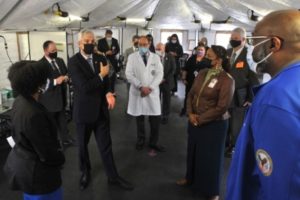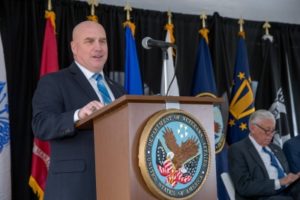VA Facilities Have Managed Wave After Wave of Infection
WASHINGTON, DC — The latter half of December and the first weeks of the new year were trying times for hospitals as the Omicron variant began sweeping across the country, causing infection rates and hospitalizations to rise to levels unprecedented even during the earliest months of the pandemic.
While vaccinations and booster shots kept the percentage of critically ill cases low, the sheer numbers, both in terms of sick patients and infected staff, made that month a stressful, uncertain time.
When Mike Heimall, director of the DC VA Medical Center, spoke with U.S. Medicine in mid-January, the surge appeared to be receding, at least in the DC-Metro area. He had just gotten off a video chat with other area hospital administrators, and someone commented that it was the first time in a while they had seen hospital directors smiling.
They were smiling, because community spread seemed to be slowing. For the DCVAMC, it was the 13th straight day of lowering positivity numbers.
Just two weeks earlier, these same administrators were seeing infection rates and COVID-19 patient numbers that dwarfed anything they had encountered in the prior two years.
One of the enduring bright lights during that dark time, at least as far as Heimall is concerned, is that, after two years of the pandemic, he had a hospital that had long-adapted to COVID and a staff who were up to the challenge.
“I can’t say enough about our staff,” he said. “They’re what got us through this.”
“This” is not only the latest surge but all the previous waves of the pandemic.
“March, April into mid-May of 2020 was the initial wave of COVID infections, and then it slowed down through the summer,” Heimall recalled. “Then it was probably early December of 2020 that we began to see the beginning of the next wave. Unlike the first wave, where we really saw it first in positive veterans, the second wave in late 2020 we really saw start with our staff.”
The hospital noticed an increased number of staff out sick with COVID-19 then became aware of the emergence of some hospital-acquired COVID-19 infections. That was very quickly gotten under control, but, by Christmas 2020, the second wave of the pandemic hit the DC region in full.
DCVAMC started 2021 with more than 20 COVID-positive inpatients and 70 to 80 staff out with COVID. Those levels persisted through January.
“We had been through one wave, so we knew what to do,” Heimall said. “We were familiar with the processes.”
The one thing that changed—and it changed things significantly—was that, on Dec. 16, 2020, the hospital administered its first vaccine.
“As we moved into January, the staff was really excited about vaccinations. It signified that now we have a weapon against this disease,” Heimall said. “That wave went by pretty quickly, I think in part because we were so focused on getting as many vaccines out as we could.”
Over the course of 2021, the DCVAMC administered more than 76,000 doses of COVID-19 vaccines and 12,000 booster shots. Approximately 77% of the hospital’s eligible veterans have been vaccinated, with as many as 17,000 more reporting that they were vaccinated at community sites.
Over spring 2021, the number of COVID-19 inpatients dwindled to a handful, and those were not significantly ill.
“There was a [very short] period in June where we didn’t have any COVID inpatients at all,” Heimall declared.
Then came the one-two punch of the delta and Omicron variants. The hospital began seeing infections rise again in mid-November. The number of patients and staff infections began to shoot up. Shortly before Christmas 2021, the hospital began seeing hospital-acquired cases.
Then came the week between Christmas and New Year.
“We [had been] seeing probably an average of five to six new infections a day. No more than 27 or 28 positive tests in any one day previously, and about 20 of those were [sent from] the state veteran’s home in Maryland,” Heimall explained. “From the 27th to 30th of December, we saw 118, 163, 136 and 133 positive cases. We had a seven-day average of 96 a day. Compared to a previous seven-day average of about four a day.”
As the year ended, the hospital had 10% of its staff out with COVID-19, while simultaneously treating up to 63 positive inpatients at one time. The high point prior to omicron was 28. All eight of the hospital’s ventilators were in use, with five taken up by COVID patients.
Dedicated COVID-19 Floor

On Denis McDough’s first full day as Secretary of the Department of Veterans Affairs, he asked to tour the DC VA Medical Center so he could see first-hand how healthcare professionals are caring for veterans during this pandemic. Photo from Feb. 12, 2021 Secretary’s Blog.
The DCVAMC has dedicated its entire fourth floor to COVID-19 care. That includes a 28-bed medical/surgical unit, an 11-bed ICU and an 11-bed step-down unit. When some of the veterans in the hospital’s community living center (CLC) tested positive, the hospital swiftly created a COVID-19 wing in the CLC.
“But all of the veterans [in the CLC] are vaccinated and boosted, so the cases we did have were asymptomatic and doing very well.”
When Heimall went home on New Year’s Eve, there was one ICU bed left in the hospital.
The hospital rode through the wave and, a week after New Year’s Day, the curve began to flatten and then trend down. As of Jan. 19, the DCVAMC was seeing about 39 positive tests a day and there were 40 COVID-positive inpatients. That number would have declined more quickly, except for the lack of beds at rehab and long-term care facilities—a problem that community hospitals were also struggling with.
As of the end of February, the inpatient number at the DCVAMC had dropped to a mere four positive patients, demonstrating that while the omicron wave might have been steep, it dropped off quickly after it passed.
However, the impact of the omicron surge on the staff might take longer to dissipate, however. In the two weeks following New Year’s, the hospital saw 6 COVID patients die.
“It has been quite a while—probably two or three months—since we’d had a death,” Heimall said. “That’s a significant number in 17 days for us.”
The hospital has had critical stress management response teams in place since April 2020, when the first staff member died from COVID-19. The teams, made up of chaplains and behavioral health specialists, are available to help staff manage their stress and grief.
There is also the ever-present danger of staff burnout, something hospitals across the country are being forced to face. According to Heimall, the DCVAMC’s job satisfaction rate has actually gone up in the last two years and its burnout numbers have not changed since 2019.
“That speaks a tremendous amount about who we have in place at the first- and second-line leadership levels,” Heimall declared.
But looking into the future, Heimall worries about recruitment and retention, especially among critical care nurses who provide the most constant, hands-on care of critically ill COVID-19 patients.
“Going into this surge, we had a number of vacancies in critical care,” Heimall said. “We’re doing a lot of work across VISN 5 to improve HR getting new candidates, but that’s been a real struggle. And I think, as a result of this pandemic, I’m concerned about the nursing profession in general. I’m worried about [nurses leaving the field], because people are burned out and tired.”
It’s not a problem that hospitals will be able to put off until COVID-19 is out of the picture. Heimall, like hospital leaders nationwide, has come to terms with the fact that the virus will be part of the landscape for years to come and that it’s unlikely that omicron is the last variant they will have to face.
But, even when COVID-19 is a thing of the past, some of the changes it has sparked will likely remain.
“We were one of the first medical centers who went to 100% use of masks and face shields in direct patient care. There were a lot of folks who were critical of that because they were concerned about the supply chain. … And we were ahead of VA nationally in requiring N95s,” Heimall said. “That was one of those things that helped us contain hospital acquired outbreaks. And I question whether that policy will go away anytime soon.”
He added, “It’s kind of like HIV was in the late 70s and early 80s where we have to put universal precautions in place and make the assumption that everybody we come into contact with has COVID and could transmit COVID to us.”
Mandatory testing will likely also be around for the foreseeable future. Patients entering the hospital are tested for COVID-19 on admission, then three days following admission and three days after that.
In the meantime, the regular growth of the hospital continues in and around COVID-19. This year, the DCVAMC will begin expanding its emergency department, starting construction on a new wing that will bring its ED beds from 11 to 22 and create a more quiet, secure space for patients experiencing behavioral health emergencies.
The DCVAMC also recently became one of only 12 hospitals in the country, and the first VA facility, to acquire the new Abbott cardiac mapping technology, which will give their cardiologists a three-dimensional picture of a patient’s heart and pinpoint any disruptions in the electrical disruptions.
“This speaks volumes to what VA does and what we should be doing here at the medical center,” Heimall declared. “We should be on the cutting edge of what’s emerging in regard to healthcare.”


